








 Français
Français
Understanding > Fundamental concepts > Phenomena VIII
PHENOMENA
of the Galilean satellites of Jupiter
The Galilean satellites are well known by all observers. They have always been popular with researchers (they look like a miniature solar system which includes very different worlds and their dynamics need all the resources of celestial mechanics) and even more since they are goals for space probes; they also are the benefit of amateur astronomers for whom these objects being quick observable objects of choice. They are bright, easily observable in small telescopes and have numerous and spectacular phenomena. Furthermore eclipses, occultations , passages and shadows, these satellites provide a rarer but more interesting show, that of mutual occultations and eclipses.
Is the ease of observing these bodies that made them ​​the first ones discovered using a telescope by Galileo in 1610. The first eclipse by Jupiter (emersion of Europa) was observed by Galileo on January 12, 1610 , but he understood its meaning in 1612. It took until 1643 for an observation of the shadow of one of the satellites of Jupiter (by Fontana) and 1693 for an observation of a mutual event ( Arnoldt : occultation of J-2 Europa by J-3 Ganymede). The observations of eclipses of Jupiter satellites were highly developed later because they were the only way to improve the tables of motion of the satellites. See the page devoted to Galilean satellites for more details about them.
The "Phenomena"
The "classical" phenomena involving the planet Jupiter
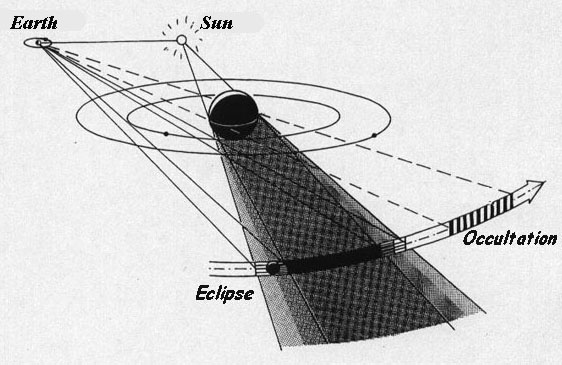
Eclipses occur when the satellites pass in the shadow of Jupiter.
Occultations occur when the satellites pass behind Jupiter for a terrestrial observer.
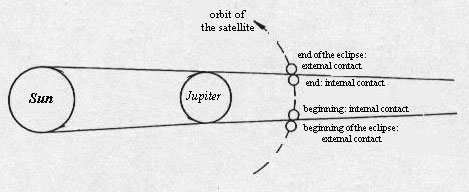
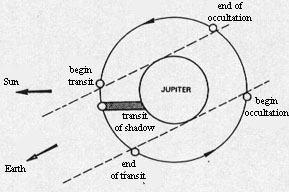
Top view "from the pole" of phenomena: transits of shadow occur when the shadow of a satellite passes over the apparent disk of Jupiter. Passages or transits occur when the satellites pass in front of Jupiter for a terrestrial observer.
The Galilean satellites present specific events due to relative positions of the Sun , Jupiter and Earth: eclipses (when a satellite is in the shadow of Jupiter), occultations (when a satellite passes behind Jupiter as seen from the Earth), the passages or transits ( when a satellite passes in front of Jupiter as seen from the Earth) and the shadow passages or transits (when the shadow of a satellite passes over the disk of Jupiter). The most famous phenomena are eclipses because they are easier to see: it is the complete extinction or the reappearance of a single satellite. Other phenomena require the simultaneous observation of Jupiter which degrades much the signal to noise ratio. All these phenomena were observed visually for decades and the large number of eclipses observed formed the basis of the first ephemeris. From the late nineteenth century, observational techniques of the observation of eclipses have been improved and the first photometric light curves have improved the accuracy of the dating of these phenomena. Then, photoelectric recording appeared , but despite the progress they brought, they were rarely used: the interest of astronomers for this type of work decreases and these observations have no more neen used for reasons that we shall see later. Improved reduction is however possible and new observations would be possible.

At right, a manuscript by Delambre related observation of an eclipse of Io beginning in Prague on January 7, 1800


At left, a photometric observation of the beginning of an eclipse by Jupiter (entry of Europa in the shadow) on April 6, 1971

Above observation of an occultation of Ganymede by Jupiter observed by the space telescope: the high definition does not solve the difficulty in identifying the instant of contact
The mutual phenomena
These phenomena are due to the relative positions of the Sun, the Earth and the two satellites. The figure below shows how the mutual events occur. The Galilean satellites are on almost coplanar orbits. Thus, when the Earth passes through this plane (ie when the jovicentric declination of the Earth becomes zero) , the satellites occult each other. Similarly, when the Sun passes through this plane (ie when the jovicentric declination of the Sun is zero), the satellites can move in the shadow of each other: there is a mutual eclipse. These phenomena, in contrast to "classical" phenomena with the planet Jupiter itself which take place continuously, occur only every six years. The lack of atmosphere on the Galilean satellites provides a low-noise signal and enables precise observation of the time of the phenomenon; the duration and the amplitude can be measured if we have the proper equipment.
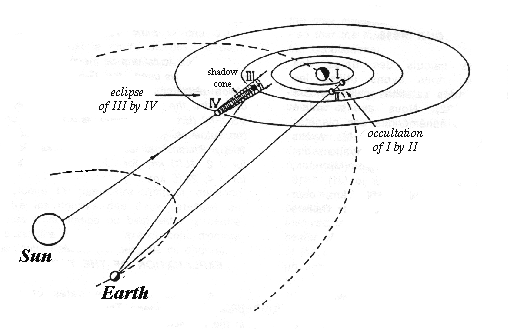
Phenomena are possible as long as these variations are close to zero. Of course, it is necessary that Jupiter and the Sun are in opposition - that is to say, viewed from Earth , Jupiter can be observed at night - and that the phenomena are observable. Finally, depending on the geocentric declination of Jupiter, the observations are more favorable to the observatories in the Northern hemisphere (for a positive declination) or Southern (for a negative declination).
The prediction of mutual events
The prediction of the mutual phenomena is complex. If it is easy to define the
favorable periods (the Earth and the Sun are in the orbital plane of the four
Galilean satellites), each phenomenon , date and specific time , is more difficult
to predict. Indeed, the four satellites are almost in the same plane and we must be
able to calculate very precisely relative positions of the satellites to determine
whether or not we have occultation or eclipse between two satellites.
If the satellites had not a so perturbated motion, the prediction calculation will
be simple: for each revolution around the planet, a phenomenon would occur. This is
not the case, and we must take into account all the periodic terms of the theory:
only the use of computers has allowed these calculations with precision. However,
some differences may appear between prediction and observation. Their analysis will
help to improve the theoretical modeling of their dynamics.
We determine if there is a phenomenon when the apparent angular distance between the
two satellites is less than the sum of apparent radii (as seen from the Earth for
the occultations and from the Sun for the eclipses). The phenomena may be partial,
total or annular (like the Moon). In the case of eclipses, there may also have
eclipse by penumbra only, but this phenomenon is not always detectable.
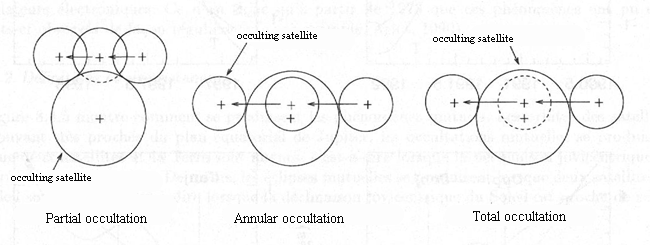
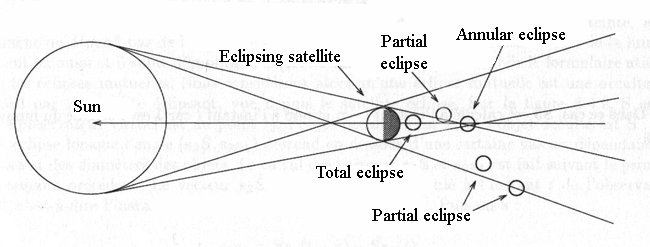
The observations
The rareness and the high accuracy of the observation of the mutual phenomena
explain the launch of observational campaigns during favorable periods. The
visibility of a phenomenon depending on the location of observers, it is necessary
that an international effort was made to cover all longitudes. Let us have a look to
what has been done in the past .
Prior to 1973, prediction calculations remained unclear and it was difficult to
reduce and use these observations because of the limited use of computers. So there
are only a few scattered observations , often made ​​by chance by observers of
classical phenomena. In the nineteenth century, the photoelectric photometry did not
exist and only a few visual observations were made, some simple conjunctions that
were not differentiated from grazing occultations .
In 1973, the period was favorable and many predictions were published. One hundred
observations were made around the world .
In 1979, the period was not favorable since the majority of events occurred during
the Jupiter-Sun conjunction. To avoid a long period of observation without mutual
phenomena , a particular effort has been made and we have rassembled a twenty light
curves observed.
In the next occurrences 1985, 1991, 1997, 2003 and 2009, the period was favorable
and we launched international campaigns observations gathering observers from all
countries spread around the Earth so that we always have an observer for which
Jupiter was visible.
The observations were photometric observations, that is to say, the observations of
the flux variation of light sent by the satellites (it's a bit like a solar eclipse
: when the Moon covers the Sun this means that the apparent positions of the Moon
and the Sun are the same, but with a higher accuracy). It is essential that all
observations are referred in the same time scale to the nearest tenth of a second of
time: the Universal Time.

Above, a series of drawings made during a mutual occultation in 1973 in Meudon with the 1m-telescope (occultation of Europa by Io June 28, 1973).
Below, an image obtained by adaptative optics for a mutual occultation in 1997 at the Observatoire de Haute Provence telescope on the 1m 52-telescope (occultation by Ganymede Europe in 1997). At right, the same image after digital processing.

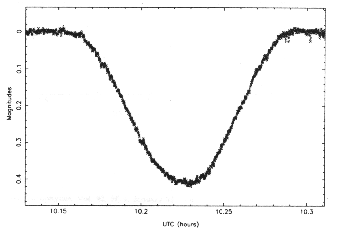
Above, a photometric light curve showing the variation of light during the occultation of Ganymede by Europa on June 10, 1985 at ESO ( photoelectric photometer 50cm-telescope).
These observations are not only relevant for the dynamical study of the Jovian system since it accurately determines the relative position of the satellites at any given time , but also for the study of the surfaces of the satellites since the drop of light during a phenomenon depends on the nature of the surface from darkness to light.
One of the most spectacular results is the observation of volcanic activity on Io, invisible from Earth, but emitting a significant infrared flux. During the occultation of a volcano by another satellite, the flow disappears, showing the position of the volcano and its activity at the time of observation.
To see the surface of Io and its volcanoes, click here.

Here at the left, the satellite configuration: Europa , smaller occults Io arriving at the top right. Loki volcano is occulted rapidly.

The model of flux variation : the volcano Loki, hidden first, drops the infrared flux received from the satellite.

The flux variation observed : the curve is noisy but there is a drop of the flux of the volcano Loki : its position and activity is measured accurately.
Credit : IMCCE
Case of the satellites of Saturn :
It should be noted that the satellites of Saturn have the same phenomena as the satellites of Jupiter . These phenomena , however, are much rarer (every 15 years) and more difficult to observe : the satellites are faint and the ring of Saturn is too bright except if the Earth is exactly in its plane (which only happens every 15 years). Below is a picture of Saturn as seen from Earth during its passage through the ring plane in 1995. We distinguish Titan's shadow and the shadow of the ring (dark) on the globe of Saturn.

Credit : J.E. Arlot, IMCCE/observatoire de Paris/CNRS